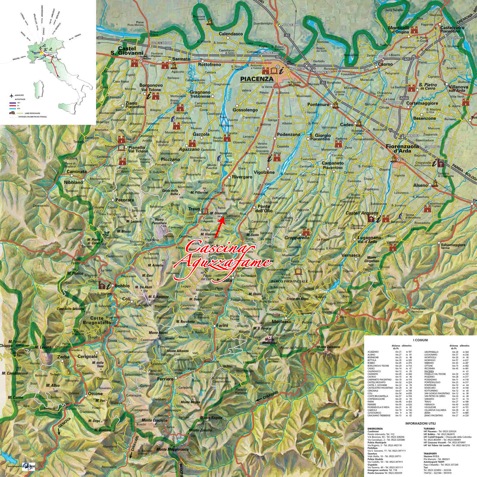The province of Piacenza has always been a central point of connection and exchange between Europe, the Po valley, Central Italy and the sea. Its physical formation and its key role mean that the province attractions are both natural and environmental as well as sites of cultural,
religious, military and commercial interest. In many points it is possible to admire and study the geological history of the zone, the stratification of the various geological eras, particularly in the Natural Geological Reserve of the Placenziano.
The villages. Important centres and villages have grown up throughout the territory: Bobbio, a medieval town, important throughout Europe for its religious, cultural and civil role in the high middle ages due to the presence of Saint Columba (the Monastery and Basilica of San Colombano, Museum, Cathedral and Castle); Castell’Arquato, a magnificent example of a medieval village (the Fortress, Collegiate Church of Santa Maria and the Geological Museum); Vigolo Marchese (the Romanesque Church and Baptistery of San Giovanni), the charming medieval Fortress of Vigoleno; Chiaravalle, which grew up around the celebrated Cistercian Abbey; Veleia (the archaeological remains of the Roman town are among the most important in northern Italy); Fiorenzuola (the Collegiate Church of San Fiorenzo and the Convent of San. Giovanni); Grazzano Visconti, an interesting neo-gothic village that was built around a medieval castle; Castelsangiovanni (the Collegiate Church of San. Giovanni) and Borgonovo, which were born as Piacentine strongholds (the Fortress and Collegiate Church of Santa Maria Assunta); Cortemaggiore, the ideal renaissance city of the Pallavicino State (the Collegiate Church and Franciscan Convent with frescoes by Pordenone); Sant’Agata with Giuseppe Verdi’s villa, the central place linked to the life of Verdi in the province of Piacenza.
Food and Wine. The province is able to offer its guests a vast and diverse choice of culinary specialities, expressing the long traditions of the farming culture: cured meats (especially coppa, salame and pancetta), pasta dishes (tortelli con la coda, anolini, pisarei e fasò, cannelloni, gnocchi, panzerotti) main courses (duck, guinea fowl, turkey, piccola di cavallo - minced horsemeat), and sweets (crostata, ciambella, briciolona cake). The guest can also choose from 21 wines from “colli piacentini”, notably Gutturnio, Ortrugo, Trebbianino Valtrebbia and Monterosso Valdarda. The oeno-gastronomy of Piacenza is promoted by more than 100 members belonging to the Association “Route of Wines and Flavours of the Hills around Piacenza”.
Province of Castles. Because of their great quality; “castle itineraries” are possible everywhere. Besides those of the villages already mentioned, others are: Rivalta (in a charming village that historians believe to have been the site of the Battle of the Trebbia between the Romans and Hannibal – 218 BC); Rezzanello; Lisignano (with its moat still full of water); Agazzano and in the nearby of the village the castles of the Bastardina and the Boffalora; Montechiaro; Statto; the Rocca d’Olgisio; Monticelli d’Ongina; Riva di Ponte dell’Olio; Gropparello; Paderna, S. Pietro in Cerro.
